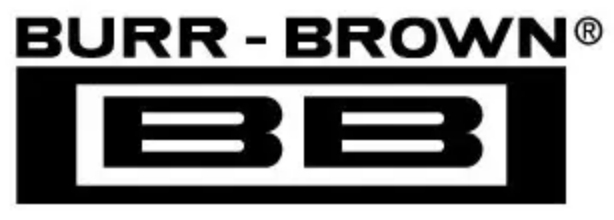1.0
Accuracy
Percent Full-Scale Range (%)
0.3
0.1
0.03
0.01
R
L
= 200Ω
0.003
0.001
0.01
Current
Output
Mode
Voltage
Output
Mode
The THD is defined as the ratio of the square root of the sum
of the squares of the values of the harmonics to the value of
the fundamental input frequency and is expressed in percent
or dB. The rms value of the PCM56 error referred to the
input can be shown to be:
∈
rms
=
1/n
∑
n
i
=
1
E (i )
+
E (i)
L
Q
2
(1)
0.1
Settling Time (µs)
1.0
10.0
where n is the number of samples in one cycle of any given
sine wave, E
L
(i) is the linearity error of the PCM56 at each
sampling point, and E
Q
(i) is the quantization error at each
sampling point. The THD can then be expressed as:
FIGURE 3. Full Scale Range Settling Time vs Accuracy.
STABILITY WITH TIME AND TEMPERATURE
The parameters of a D/A converter designed for audio
applications should be stable over a relatively wide
temperature range and over long periods of time to avoid
undesirable periodic readjustment. The most important
parameters are Bipolar Zero Error, Differential Linearity
Error, and Total Harmonic Distortion. Most of the Offset
and Gain drift with temperature or time is due to the drift of
the internal reference zener diode. The PCM56 is designed
so that these drifts are in opposite directions so that the
Bipolar Zero voltage is virtually unaffected by variations in
the reference voltage. Both DLE and THD are dependent
upon the matching and tracking of resistor ratios and upon
V
BE
and h
FE
of the current-source transistors. The PCM56
was designed so that any absolute shift in these components
has virtually no effect on DLE or THD. The resistors are
made of identical links of ultra-stable nichrome thin-film.
The current density in these resistors is very low to further
enhance their stability.
DYNAMIC RANGE
The Dynamic Range is a measure of the ratio of the smallest
signals the converter can produce to the full-scale range and
is usually expressed in decibels (dB). The theoretical dynamic
range of a converter is approximately 6
x
n, or about 96dB
of a 16-bit converter. The actual, or useful, dynamic range is
limited by noise and linearity errors and is therefore somewhat
less than the theoretical limit. However, this does point out
that a resolution of at least 16 bits is required to obtain a
90dB minimum dynamic range, regardless of the accuracy
of the converter. Another specification that is useful for
audio applications is Total Harmonic Distortion.
TOTAL HARMONIC DISTORTION
THD is useful in audio applications and is a measure of the
magnitude and distribution of the Linearity Error, Differential
Linearity Error, and Noise, as well as Quantization Error. To
be useful, THD should be specified for both high level and
low level input signals. This error is unadjustable and is the
most meaningful indicator of D/A converter accuracy for
audio applications.
5
THD
= ∈
rms
/ E
rms
1 /n
∑
n
i
=
1
E (i )
+
E (i)
L
Q
2
(2)
X
=
E
rms
where E
rms
is the rms signal-voltage level.
100%
This expression indicates that, in general, there is a correlation
between the THD and the square root of the sum of the
squares of the linearity errors at each digital word of interest.
However, this expression does not mean that the worst-case
linearity error of the D/A is directly correlated to the THD.
For the PCM56 the test period was chosen to be 22.7µs
(44.1kHz), which is compatible with the EIAJ STC-007
specification for PCM audio. The test frequency is 991Hz
and the amplitude of the input signal is 0dB, –20dB, and
–60dB down from full scale.
Figure 4 shows the typical THD as a function of output
voltage.
Figure 5 shows typical THD as a function of frequency.
10.0
Total Harmonic Distortion (%)
1.0
14 Bits
0.1
0.01
16 Bits
0.001
–60
–50
–40
–30
V
OUT
(dB)
–20
–10
0
0dB = Full Scale Range (FSR)
FIGURE 4. Total Harmonic Distortion (THD) vs V
OUT
.
®
PCM56

 BURR-BROWN [ BURR-BROWN CORPORATION ]
BURR-BROWN [ BURR-BROWN CORPORATION ]